How can we make experiences that pay their way?
Too often, too many experiences fly like Icarus… as soon as they begin to soar, the wax heats up, the wings break and they fall to Earth. Take these examples:
- Peaky Blinders: The Rise – one of the WXO’s stand-out experiences of 2022/23, this immersive theatrical spectacular closed in April 2023 after 10 months.
- Punchdrunk: The Burnt City – love it or hate it, the iconic immersive theatre company’s latest production closed in September 2023, a year and half since launching.
- TRANSFIX – this Las Vegas immersive art show brought some serious experience talent on board, but still shuttered its doors in May 2023 after just one month.
- Rumble In The Jungle Rematch – another boundary-breaking immersive experience we loved, but which closed in December 2023 after only four months.
So how can we make sure amazing experiences don’t just launch, but stick around long enough to convert more people to spend more time and money on experiences? Not to mention generate great returns for their creators and backers?
Simple. We need to talk about the Economics of Immersive.
Back by popular demand, we repeated our first IRL Campfire online and for a global audience. When it comes to the economics of experiences, we’ve noticed the same questions cropping up from our community. For those working on b2b experiences, the focus is on how to prove return on experience (ROX). And for those working on b2c experiences, it’s about having the emotional and artistic impact you want – while staying sustainable and open for the long run.
We set out to answer these questions and figure out how to create experiences that scale, drive repeat business, and make money. We drew together insights from experience creators and specialists to help guide our projects to financial sustainability – and even success. And we shared numbers and stories of success and failure in a safe, supportive space.
This is all part of our wider project to define the rules of ROX and how to benchmark experiences – for more details and to join our working groups, apply to join the WXO today.
The 5 Rules Of Revenue
When it comes to revenue, it’s natural that your first focus as an experience creator might be on ticketing. However, through several previous Campfires we’ve identified five rules of revenue that highlight where you might be missing out on other potential means of increasing revenue.
Rule 1: The LBE Rule Of Thirds

In our special Campfire on Immersive IP, Habo Studio shared some of their research into the revenue strategies of family entertainment centers (FECs) and location-based entertainment (LBEs). They found that while ticketing accounted for 34% of revenue, 30% came from corporate events, and the biggest slice came from ancillary revenue like F&B and merch, at 35%. Experience creators should therefore ask themselves: if I’m only focusing on ticketing, where might I be missing out?
Rule Two: Reserve Your Time. Create An Avatar
In Social Entertainment: The Immersive Adventure, experience specialist Kevin Williams shared his four “MULE Rules”, MULEs being Mixed-Use Leisure Entertainment. The first is that if you have your customers reserve their time in your experience and create an avatar, you can follow the guest journey from search to landing on the website to booking, making sure that you create a compelling reason to sign up and that they have a discount and details to share.
Rule Three: From Perchables To Collectibles, Let Your Consumers Consume
Make consuming part of the experience through food and drink and novelty or special items. “Perchables” are disposable items (bearing in mind that sustainability should also be a consideration), and “collectibles” are items that are worth keeping, acting as a memory anchor and status symbol. F&B can require star chefs – but it can also be done through food trucks or stalls, such as at London’s Fairgame or Brooklyn’s Royal Palms Shuffleboard Club. Or think of Butterbeer at Harry Potter World, one of the fastest-selling, most profitable products ever sold in a theme park. This presents an opportunity to not only improve your revenue, but improve the experience for your guests.
Rule Four: Create A Repeat Visitation Environment
You can encourage repeat visits by generating a score linked to the visitor’s avatar that they then want to improve, creating a subscription model, setting up “streaks”, or hosting watch parties. For more tips on creating a repeat visitation environment, see ex-Secret Cinema’s Andrea Moccia on How To Turn Visitors Into Repeat Visitors.
Rule Five: The Reasons For $easons

Prizes and special deals can keep people coming back and seasonality keeps your story fresh, giving a reason to return. British immersive adventure Phantom Peak captures this well – it stages different seasons and storylines throughout the year and has a 30% repeat visitor rate. Discover more about how they achieve this impressive stat in The Vital Role Of Story In Open-World & Immersive Experiences.
3 Cost Considerations
Even if you’re aware of how to maximise your potential revenue streams, there will still be features of your experience that will affect your costs and need to be built in from the start. Three classic examples of such cost considerations are:
- Capital / launch expenditure (CapEx) vs operating / ongoing expenditure (OpEx). When it comes to OpEx, the number of people it takes to deliver your experience will be key – operating experiences “walk on two legs”, after all.
- Digital-first (CapEx) vs interactor-led (OpEx). It follows from above that if your experience is digital-first, you might spend a lot of money building it, but then it will run at a relatively low cost. But if you rely on lots of actors, your operating costs will be high. As Melanie Goodwin points out: “Punchdrunk and Peaky Blinders: The Rise need massive talent to bring them to life. Meow Wolf, on the other hand, has few roaming characters and logistical staff. Your attraction can’t be just people, or you need to look at theatre models that have government grants and funding, big brand sponsors, and which tour.”
- Experiential depreciation vs experiential appreciation. This is the gradual decline in perception of your experience over time, in how it both looks and feels. How can you create something timeless that might stick around?
How To Fix Experiential Depreciation
“Experiential depreciation is the gradual decline in the overall perceived value of a visitor experience over time… wear and tear caused by factors such as human interaction, environmental elements, and the passage of time itself. From the moment a new experience opens… it begins to face the forces that erode the quality of the visitor experience.”
Chris Wilson, Chief Creative & Operating Officer, Bridgewater Studio
The solution is to pay attention to the three Pillars of Relevance:
- Aesthetic relevance. Does your experience look like someone cares? Does it look timeless – or like something a visitor should give their time? Does it feel like it did the day it opened?
- Content relevance. Is the content up to date? Does it matter to your audience, and meet them where they are?
- Tactical relevance. Does your storytelling land with all visitors irrespective of age, ability, culture or any other vector of human difference? As audience expectations of how we consume stories shifts – with the introduction of new story shapes or new technologies such as AR, for example – how will your experience adapt?
More Money-Making Tips From The WXO Community
When we opened up the conversation to the wider group, a few additional themes emerged about how best to make money and keep your experience sustainable. These are just a snippet of the discussion – to listen and share live, find out more about WXO Campfires here…
Collaborate with your community.
“We have really been up against the How – and we reached out to our Customer Base to explore that. With them we are exploring Partronage (their idea), Collaborating with our Rabid Fans to create HoT Leads/Referrals (combined them/us idea), and exploring Multi-Agency Co-operative Memberships (Customers, Employees, Vendors/Suppliers, Investors)”
Adrienne Fritze, Conundrum House
Find brand and corporate sponsors
“One thing I see missing is brand partnership/sponsorships. Yes… it is ‘selling out’ but it can be a small price to pay if it means keeping the doors open – and it can be done tastefully. Most symphonies have corporate sponsors. At Color Factory, each different room had a sponsor, which I imagine covered the hard costs of building the space. And at corporate special events, you can charge a lot more per person and activate the space after hours.”
Melanie Goodwin, creative director
Tour your experience
“Immersive attractions should consider touring. Broadway shows travel with limited runs, Van Gogh travels, Stranger Things travels, Color Factory travels. Too many experiences expect something to last indefinitely in one location.”
Melanie Goodwin, creative director
“We’re looking to create a loose network of places for these shows to land. We’re not only acquiring content for our cities, but creating a way shows and content creators can tour between venues in a sustainable way, similar to touring concerts, where we can focus on being good hosts and good marketers. There is a clamour for great content.”
Tom Gabbard, Blumenthal Performing Arts
Find the right funding
“What about funding? The experiences that survive are often the ones backed by millions of dollars versus the scrappy start-ups who want to make beautiful things”
Daniel Gomez, First Person Xperience
(We’ll be hosting two Campfires on What Experience Investors Want with immersive entertainment producer Soren West later this season. In the meantime, check out our previous Campfire with Wake The Tiger’s Graham Macvoy for tips on how to get from pitch deck to fully realised immersive world, and our early Campfire with Creative Startups’ Alice Loy on How To Turn Your Creative Idea Into Big Business.)
Understand your market
“We’ve learned at COCOLab that if you don’t understand how different operators work, you can’t really reach tourists. We’ve made things that completely ignored that, and what happens is that the people selling tickets on the street and in hotels weren’t pushing our experience. Everybody always gets a cut. If you don’t incorporate that in your ticketing pricing strategy, you’ll start cannibalising your different tickets and lose a lot of potential.”
Miguel Melgarejo, COCOLab
Start small and scale over time
“At an experience I worked on, there was an over bloat in investment on ancillary revenue at the start, building VIP/sponsor boxes and bespoke bars without a sales team to sell them. You have to scale by planning for these things over time, not out the gate. Start with minimum merch and performances, then scale up over time.”
Heather Gallagher, transformative experiences expert
The WXO Take-Out
The questions of how to secure investment for your experience, maximise your revenue streams, minimise your costs and keep everything sustainable over time are big ones that will take time and collaboration to solve.
However, we’re at an incredibly exciting point for the mass adoption of experiences – and coming together to define the rules, considerations and tips that will help safeguard incredible experiences against an early death will only help to support this growth. At the WXO, we’re planning more talks, debates and working groups on the Business of Experiences to help us get there faster.
So next time you’re designing an experience, ask yourself:
- How do you plan for capital expenditure / launch costs vs operating expenditure / ongoing costs?
- What are the differences between the economics of digital-first and actor-led experiences?
- How do you plan – and budget – for experiential depreciation?
Want to come to live Campfires and join fellow expert experience creators from 39+ different countries as we lead the Experience Revolution forward? Find out how – and the current speaker line-up – here.





